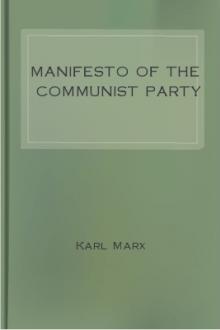The Communist Manifesto - Karl Marx (reading women .TXT) 📗

- Author: Karl Marx
Book online «The Communist Manifesto - Karl Marx (reading women .TXT) 📗». Author Karl Marx
But with the development of industry the proletariat not only increases in number; it becomes concentrated in greater masses, its strength grows and it feels that strength more. The various interests and conditions of life within the ranks of the proletariat are more and more equalized, in proportion as machinery obliterates all distinctions of labor, and nearly everywhere reduces wages to the same low level. The growing competition among the bourgeois, and the resulting commercial crises, make the wages of the workers ever more fluctuating. The unceasing improvement of machinery, ever more rapidly developing, makes their livelihood more and more precarious; the collisions between individual workman and individual bourgeois take more and more the character of collisions between two classes. Thereupon the workers begin to form combinations (Trades’ Unions) against the bourgeois; they club together in order to keep up the rate of wages; they found permanent associations in order to make provision beforehand for these occasional revolts. Here and there the contest breaks out into riots.
Now and then the workers are victorious, but only for a time. The real fruit of their battles lies not in the immediate result but in the ever improved means of communication that are created in modern industry and that place the workers of different localities in contact with one another. It was just this contact that was needed to centralize the numerous local struggles, all of the same character, into one national struggle between classes. But every class struggle is a political struggle. And that union, to attain which the burghers of the middle ages, with their miserable highways, required centuries, the modern proletarians, thanks to railways, achieve in a few years.
This organization of the proletarians into a class and consequently into a political party, is continually being upset again by the competition between the workers themselves. But it ever rises up again; stronger, firmer, mightier. It compels legislative recognition of particular interests of the workers, by taking advantage of the divisions among the bourgeoisie itself. Thus the ten-hours’ bill in England was carried.
Altogether collisions between the classes of the old society further, in many ways, the course of the development of the proletariat. The bourgeoisie finds itself involved in a constant battle. At first with the aristocracy; later on, with those portions of the bourgeoisie itself whose interests have become antagonistic to the progress of industry; at all times with the bourgeoisie of foreign countries. In all these countries it sees itself compelled to appeal to the proletariat, to ask for its help, and thus to drag it into the political arena. The bourgeoisie itself, therefore, supplies the proletariat with weapons for fighting the bourgeoisie.
Further, as we have already seen, entire sections of the ruling classes are, by the advance of industry, precipitated into the proletariat, or are at least threatened in their conditions of existence. These also supply the proletariat with fresh elements of enlightenment and progress.
Finally, in times when the class struggle nears the decisive hour, the process of dissolution going on within the ruling class, in fact within the whole range of old society, assumes such a violent, glaring character, that a small section of the ruling class cuts itself adrift, and joins the revolutionary class, the class that holds the future in its hands. Just as, therefore, at an earlier period, a section of the nobility went over to the bourgeoisie, so now a portion of the bourgeoisie goes over to the proletariat, and in particular, a portion of the bourgeois ideologists, who have raised themselves to the level of comprehending theoretically the historical movement as a whole.
Of all the classes that stand face to face with the bourgeoisie today, the proletariat alone is a really revolutionary class. The other classes decay and finally disappear in the face of modern industry; the proletariat is its special and essential product.
The lower middle class, the small manufacturer, the shopkeeper, the artisan, the peasant, all these fight against the bourgeoisie to save from extinction their existence as fractions of the middle class. They are therefore not revolutionary, but conservative. Nay, more, they are reactionary, for they try to roll back the wheel of history. If by chance they are revolutionary, they are so only in view of their impending transfer into the proletariat; they thus defend not their present, but their future interests, they desert their own standpoint to place themselves at that of the proletariat.
The “dangerous class,” the social scum, that passively rotting class thrown off by the lowest layers of old society, may, here and there, be swept into the movement by a proletarian revolution; its conditions of life, however, prepare it far more for the part of a bribed tool of reactionary intrigue.
In the conditions of the proletariat, those of old society at large are already virtually swamped. The proletarian is without property; his relation to his wife and children has no longer anything in common with the bourgeois family relations; modern industrial labor, modern subjection to capital, the same in England as in France, in America as in Germany, has stripped him of every trace of national character. Law, morality, religion, are to him so many bourgeois prejudices, behind which lurk in ambush just as many bourgeois interests.
All the preceding classes that got the upper hand sought to fortify their already acquired status by subjecting society at large to their conditions of appropriation. The proletarians cannot become masters of the productive forces of society, except by abolishing their own





Comments (0)